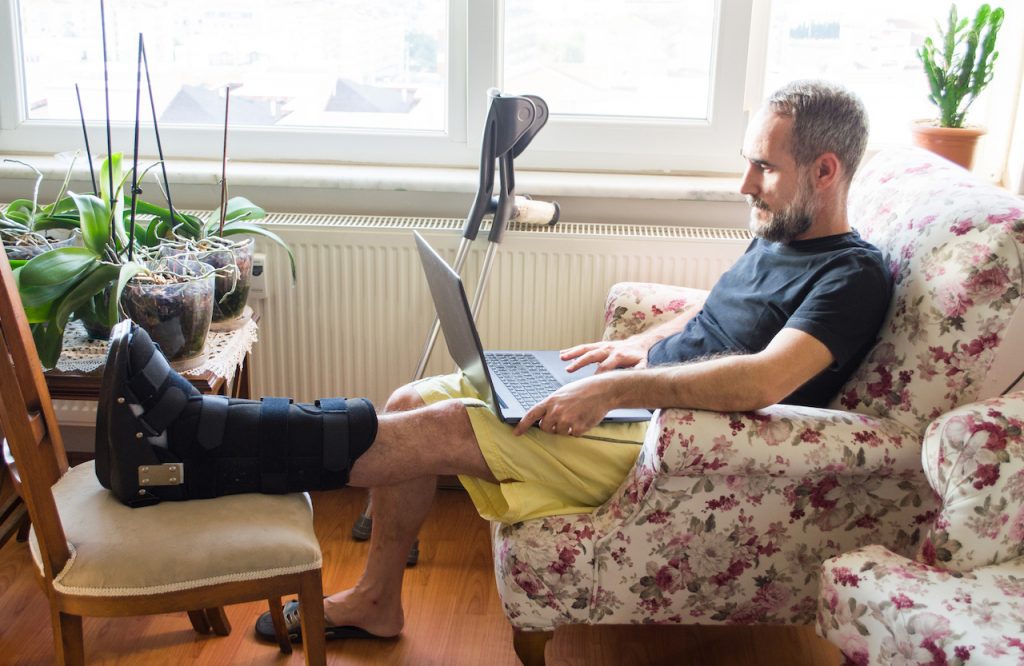Ankle Surgery Recovery: What You Need to Know Before and After
 When you sustain an ankle injury, surgery may be in the near future. If a surgical procedure is necessary, you might have a few questions about what to expect and be nervous about the road ahead. At Orthopaedic Hospital of Wisconsin, we want to provide you with enough information to help put your mind at ease and help you feel comfortable about your upcoming procedure. David Tranchita, PT, OCS, CMTPT, CSCS, is a skilled physical therapist specializing in helping patients recover from orthopedic surgery and conditions. Below, Tranchita provides a guide on what to expect from ankle surgery and tips for ankle surgery recovery that can get you “back on your feet” as soon as possible.
When you sustain an ankle injury, surgery may be in the near future. If a surgical procedure is necessary, you might have a few questions about what to expect and be nervous about the road ahead. At Orthopaedic Hospital of Wisconsin, we want to provide you with enough information to help put your mind at ease and help you feel comfortable about your upcoming procedure. David Tranchita, PT, OCS, CMTPT, CSCS, is a skilled physical therapist specializing in helping patients recover from orthopedic surgery and conditions. Below, Tranchita provides a guide on what to expect from ankle surgery and tips for ankle surgery recovery that can get you “back on your feet” as soon as possible.
Am I a Candidate for Ankle Surgery?
Surgery may address several foot and ankle conditions from bunions to tendon tears and severe arthritis. Typically, foot and ankle surgery is considered after nonsurgical treatments have been unsuccessful. However, certain conditions, especially acute injuries such as ankle fractures, may require immediate surgery.
Numerous surgical procedures treat foot and ankle conditions. Depending on the type of condition, the goal of the surgery may be to align broken bones, fuse painful joints, remove overgrown tissue or repair a torn ligament or tendon. In cases of significant damage, arthritis, and severe pain in the ankle joint, a total ankle replacement may be recommended by your orthopedic surgeon.
If you have decided on surgery for your ankle injury or condition, your doctor will immediately inform you about the surgical plan. Planning for surgery can be intimidating. At Orthopaedic Hospital of Wisconsin, we are here to ensure you feel comfortable before, during, and after surgery. Our staff is available to assist you every step of the way. Should you have any questions, do not hesitate to reach out at any time.
What Are Common Ankle Surgeries?
Lateral Ankle Ligament Reconstruction
- Ligaments in your ankle help keep your ankle and foot stable when you walk, run and play sports. If you have repeated ankle sprains or have foot deformities, your ligaments can start to get weak and loosen. If this happens, your ankle may become unstable and may warrant surgery. A lateral ankle ligament reconstruction is a surgery to tighten and firm up one or more ankle ligaments on the outside of your ankle. It’s also known as the Brostrom procedure. Frequently, it is an outpatient surgery, so you can go home the same day.
- Recovery is 8-12 weeks when combined with a physical therapy program. How fast your return to work, recreational activities or sports is dependent on the extent of the surgery, the health of the patient, and utilizing physical therapy.
Achilles Tendon Repair
- The Achilles tendon is a strong, fibrous cord in the lower leg that connects your calf muscles to your heel. It’s the largest tendon in your body that helps you walk, run, and jump. The Achilles tendon can become irritated or damaged from overuse or repetitive movements. This is also known as tendinitis or tendinopathy. It can develop symptoms like pain and stiffness along your Achilles tendon and on the back of your heel. Having short or tight calf muscles can increase your risk of tendinopathy.
- In some cases, the Achilles tendon can tear or rupture. This is usually due to a sudden, strong force. It can happen during physical activity with sudden, fast movements or pivoting on your foot, such as basketball, tennis, soccer, and other sports. A ruptured Achilles tendon causes sharp pain in the calf as if someone kicked them. It will be weak and difficult to point your foot downward.
- Recovery from this surgery is lengthy. You will need to wear a cast or a boot for 3 to 4 weeks after surgery and be non-weight bearing. At 6-8 weeks, you will be in a walking boot with gradually increasing weight-bearing with guidance from your physical therapist.
- How soon you can return to your work depends on your job. If you sit at work, you may be able to go back in 2 to 3 weeks. But if you are on your feet at work, it may take 6 to 8 weeks. If you are very physically active in your job, it may take 3 to 6 months.
Fractures and Ankle Surgery
- Most simple fractures heal well with immobilization and non-weight-bearing activity. Many ankle fractures take 4-8 weeks for the bones to heal completely and up to several months to regain full use and range of motion of the joint.
- If a fracture is comminuted (broken in more the one place), displaced (separated too far apart and not aligned) and open (breaks through the skin), it will most likely require surgery to prevent further damage. Severe ankle fractures will be treated with open reduction internal fixation (ORIF) surgery. In ORIF, surgeons open up your injured ankle and line up the ends of your broken bones. They might also install metal plates, wires, or screws to keep your ankle bones stable while the bones heal.
- Recovery from this surgery takes at least 6 to 8 weeks. Severe fractures take up to 12 weeks to heal. You may get back to a functional level faster when combined with a physical therapy program.
Ankle Fusion
- An ankle fusion is a type of surgery to fuse the bones of your ankle into one piece. It’s also known as ankle arthrodesis. The surgery is often to treat arthritis in the ankle.
- It reduces the symptoms of ankle arthritis like pain, inflammation, and swelling.
- Activities, including driving, can resume in about three to four months, but more rigorous activities like sports will need to wait even up to a year or more if the fix is to be long-lasting. The screws and plates will remain in the ankle unless they start causing any issues such as irritation or pain.
- Be sure and discuss any return to work with your surgeon. It can take up to one year to feel the full benefits of subtalar fusion.
- Recovery time is usually 6 to 12 weeks when combined with a physical therapy program.
Ankle Surgery Recovery
After orthopedic surgery, it can be tempting to resume your regular level of activity as soon as possible. In truth, it is vitally important you take the steps necessary to help your body recover during ankle surgery recovery. Post-surgery, you will have recovery directions from your doctor. Depending on the surgery you are recovering from you may also be instructed to follow a physical therapy program. Following the instructions of your doctor and/or physical therapist will help to ensure that your surgical results are satisfactory.
The healing time for any injury is based on physiological factors. Recovery time can also be influenced by your age, psychological, stress, comorbidities (e.g. diabetes, peripheral artery disease, and obesity), alcohol use, use of medications, infections, type/extent of surgery, immobilization, smoking, and malnutrition. A better understanding of the influence of these factors on repair may lead to therapeutics that improve wound healing and resolve impaired wounds. Your wound or incision will normally heal and scar down in 2-3 weeks. Below are a few recovery ideas you may be presented with following ankle surgery.
Nutrition is Vital to Recovery
While eating a healthy diet is important throughout your life, a well-balanced diet is especially vital for ankle surgery recovery. Vitamin A, Vitamin C, and Zinc can help your body to repair tissue damage, fight infections, and keep your skin healthy. Vitamin A is in animal foods and some brightly colored vegetables and fruits. Many vegetables and fruits are high in vitamin C. Zinc deficiency has been associated with delayed wound healing, reduced skin cell production, and reduced wound strength. Some dietary zinc sources include red meat, fish and shellfish, milk products, poultry, and eggs.
Recover From Ankle Surgery with the P.R.I.C.E. Method
- Protect: Early on, you will be wearing a cast, boot, or splint to help protect the ankle. Per your surgeon’s orders, you will slowly wean off this support and into a regular, supportive shoe.
- Rest: As difficult as it may be with a busy schedule, it is vital to give your body the resting time to recover. Get off your feet periodically throughout the day to rest.
- Ice: Ice is a natural anti-inflammatory and a fantastic way to reduce swelling.
- Compression: Use a compressive Ace wrap, compression sleeve, or TED hose stockings, especially once you begin to walk and are in a standing position for longer periods. This improves circulation and prevents swelling from pooling into your foot.
- Elevation: Make sure to elevate your foot above your heart when you are off your feet and during icing periods.
If you have experienced an ankle injury or suffer from a painful ankle condition, request an appointment with one of our orthopedic specialists today. Following their instruction, you can ensure a complete and impactful recovery.

